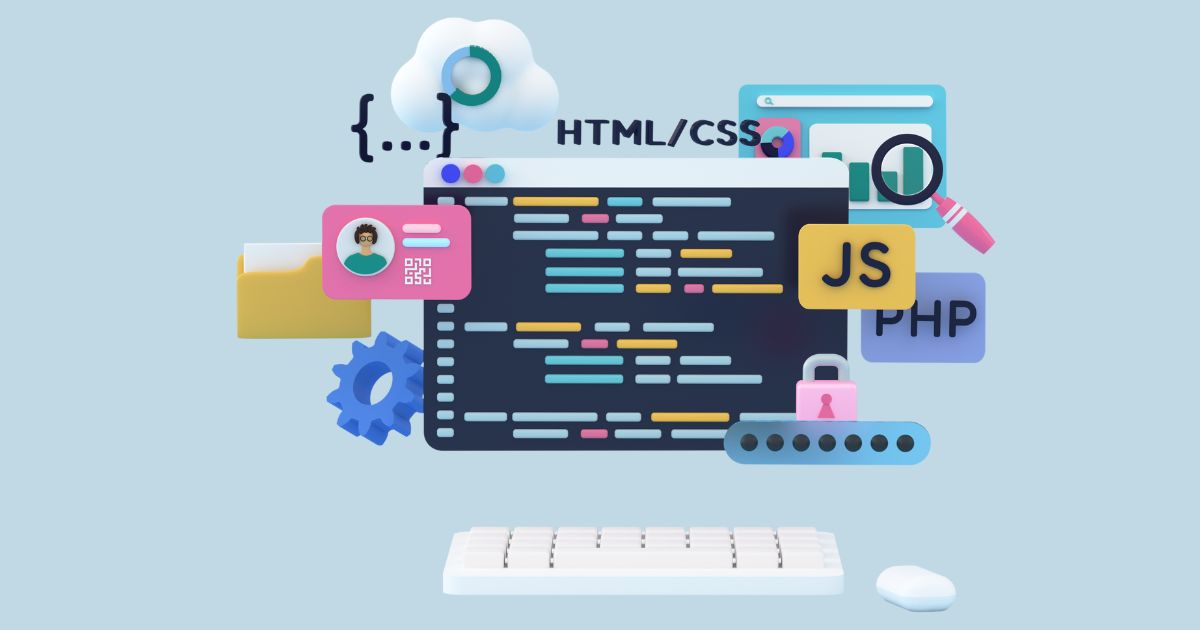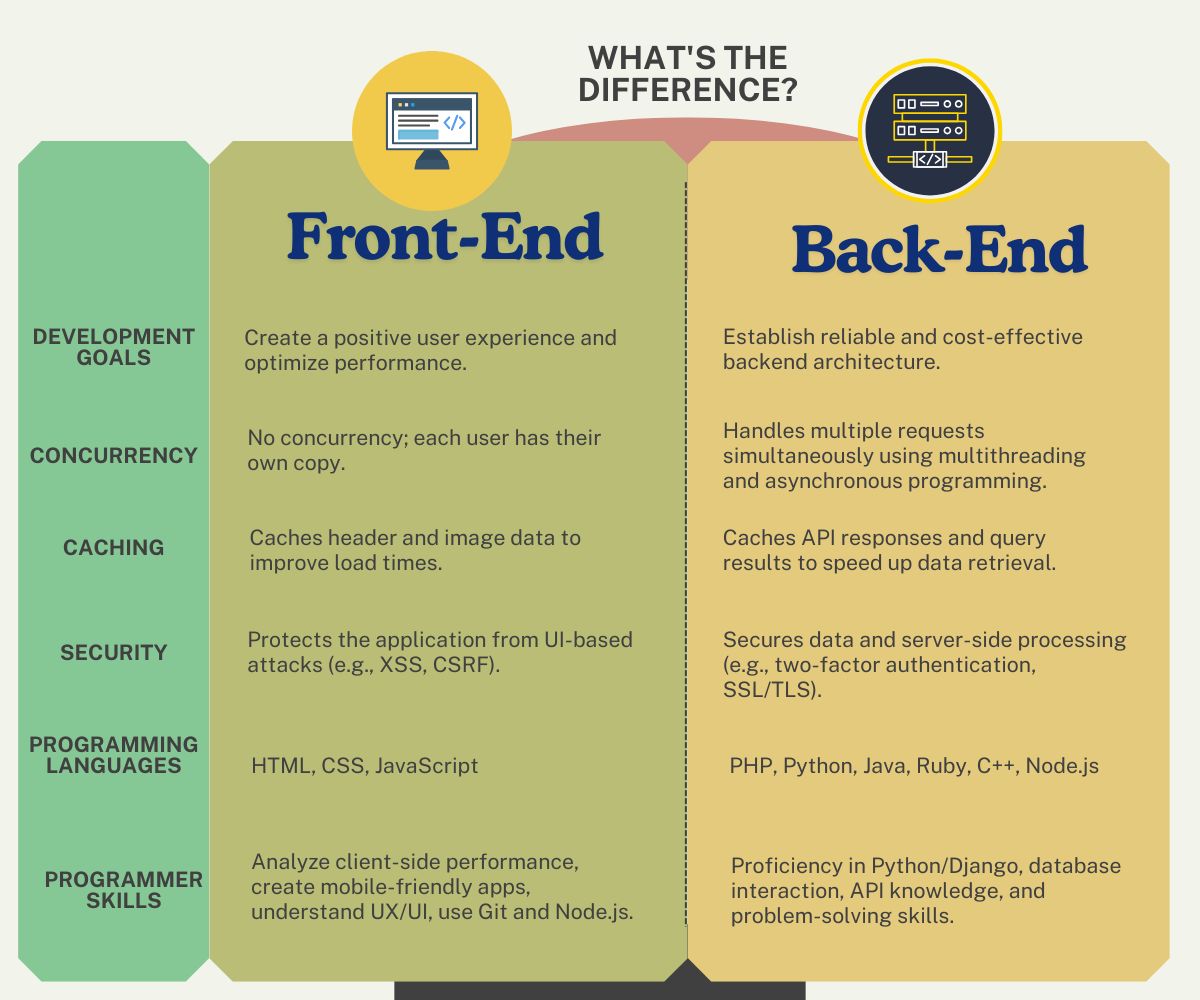Front-End vs Back-End: What's the difference?
Front End and Back End are two very familiar terms in the field of software development. These are two important components that cannot be separated in the process of developing Web or Mobile applications. However, Front End and Back End have many differences. In this article, Skilltrans compares Front End vs Back End in many aspects to help you have the most general view of the two programming areas above.
What is Frontend?

The Front End is what users can see, interact with, and experience on a website. Front-end Development is the mission effectively implementing of a web application's visual components.
The main task of a Front End Developer is to program the visible parts of a website or application so that users can interact with them.
Frontend Developer’s Jobs
The jobs of a Frontend developer include:
Designing and building websites, web, and mobile applications
Developing user interfaces (UI) and user experience (UX) to increase aesthetics, comfort when using
Building and optimizing HTML, CSS, and JavaScript code. To create a faster loading speed of the website, friendly to search engines (SEO)
Use graphics tools and software to create graphic elements, images, and videos.
Languages and technologies for Frontend
Popular languages and technologies for Frontend include:
HTML: Hypertext Markup Language to define the structure of the website
CSS: Formatting language to format elements on the website, including colors, fonts, spacing, and width
JavaScript: Programming language to create dynamic interactions on the website, including responsiveness, animation, and other interactive functionality
ReactJS: A popular JavaScript library for building dynamic and maintainable web applications
AngularJS: A JavaScript framework for building dynamic and maintainable web applications
Vue.js: A lightweight JavaScript framework for building dynamic and maintainable web applications.
What is Backend?

Back-end is a part of information technology. It is responsible for data processing and database interaction of web and mobile applications. It is the “underneath” part of the application. Where complex tasks such as request processing, data processing, and database management are performed.
Backend developer jobs
Backend developer jobs are:
Designing, building, and maintaining web or mobile applications
Programming data processing functions and other complex tasks such as payment processing, login, user management, data management, etc.
Optimizing the performance of web or mobile applications to have fast response speed and stability.
Connect applications to databases and other systems to ensure data integrity and security.
Build APIs (Application Programming Interfaces) to allow other applications to connect and interact with your system.
Languages and technologies for Backend
Popular languages and technologies for Backend include:
PHP: Popular programming language for web applications, especially WordPress and Drupal
Java: Best programming language choice for enterprise applications and mobile applications. Java is used by large companies such as Google, Amazon and Twitter.
Python: Simple and easy-to-learn programming language. Used for web applications and data science
Ruby: Programming language used for web and mobile applications. Especially Ruby on Rails - a popular framework for dynamic web applications.
Node.js: A development platform built on JavaScript. It allows developers to use JavaScript on both the client and server sides.
MySQL: A popular relational database management system (RDBMS) for web and mobile applications
MongoDB: Non-relational database management system (NoSQL) for web and mobile applications.
Front End vs Back End: Overview of the differences
Front End and Back End contribute to building functional websites or applications, but their focus areas are quite different.
| Aspect | Front End | Back End |
| Definition | Front End focuses on the visual components of a website or application that we see or interact with. | Back End includes database implementation and server-side logic processing. |
| Technology | Programming languages HTML, CSS, JavaScript, and frontend frameworks. | Programming languages such as Python, PHP, Java, Ruby, ... |
| Independence | Front End can still operate independently but can only build static pages. Logic with database, login, user information, ... Still need Back End | Operate independently of the frontend structure. But only the background processing logic, API, etc. can be developed so that the application has an interface and interaction that needs to be combined with the Front End. |
| Concurrency | Each user has a separate copy of the application, so the front end does not have concurrency. | The Back End uses different strategies to handle multiple user requests at the same time. |
| Development goals | The development goal of Front End Programming is to create a multifunctional, responsive, and well-structured user interface. | Backend programming aims to build a secure, reliable data processing and storage process to support frontend development. |
| Framework, Javascript library | Angularjs, Reactjs, Vuejs, jQuery, Next.js, etc. | Django, Laravel, Ruby, CakePHP, Flask, Express.js, Spring Boot, etc. |
| Security | Frontend programmers focus on input data validation, user authentication, application security such as cookies, CSP (Content Security Policy), checking the Subresource Integrity (SRI). | Security is a major part of the backend as it protects the database, prevents attacks, authenticates, encrypts, logs errors, etc. |
| Temporary storage | The browser or application stores files from the application, using them to improve performance. | The backend system stores files on different servers or in a CDN. Caches data to increase speed. |
| Development skills | Frontend developers are proficient in HTML, CSS, JavaScript and use frontend frameworks to create visually appealing websites. | Backend developers are proficient in programming and database management skills. They are familiar with secure code, application development tools, frameworks, and platforms. |
| Additional skills required | UI/UX design. | Problem analysis and solving. |
Front End vs Back End: Differences in Detail

We have a general understanding of the difference between Front End and Back End, so let's analyze more deeply with Skilltrans through the analysis below.
Front End vs Back End: Development Goals
The main goal of both Frontend and Backend is to build a functional website, application, software, but to do this, Frontend and Backend have different goals:
Frontend programming aims to create a positive user experience by optimizing quality and performance. The goal is to build user-friendly websites that are easy to navigate on any device.
Backend programming focuses on creating efficient and streamlined solutions. The main goal is to establish reliable and cost-effective backend architecture.
Front End vs Back End: Concurrency
Concurrency means the ability to perform multiple tasks at the same time. Each user has their own copy of the website in their local browser. Therefore, the front end does not have concurrency.
In contrast, the backend processes multiple requests and responses at the same time. To manage this, backend programming must use multithreading and asynchronous programming, callbacks and promises, as well as locking and synchronization.
Front End vs Back End: Caching
Temporary storage is where a copy of the web application is stored, which improves overall performance by reducing the load time of the website. In frontend programming, developers often cache header and image data in the cache, which helps users load data quickly when they visit the website a second time.
In backend programming, temporarily caching API responses and database query results in cache is a common technique to speed up data retrieval. This way, when a similar request comes in, the system can return results from the cache instead of recalculating them, reducing server load and shortening response times, thereby improving user experience.
Front End vs Back End: Security
Security in web development is an important issue in both front end and back end. Front end focuses on protecting the application from attacks through the user interface, such as validating input data, preventing XSS (Cross-Site Scripting) and CSRF (Cross-Site Request Forgery).
Meanwhile, backend focuses on the security of data and server-side processing, preventing database attacks, protecting login credentials and other sensitive data. Backend security measures typically include two-factor authentication, SSL/TLS data encryption, and role-based access control.
Front End vs Back End: Programming Languages
Front End vs Back End programmers will communicate with the computer through specific code of each programming language. Therefore, the programming languages of Front End and Back End are also very different.
Programming languages of Front End developers
Front-end developers use programming languages: HTML, CSS, and JavaScript.
HTML (Hyper Text Markup Language). HTML is the standard programming language for implementing the content and general structure of the website.
CSS (Cascading Style Sheets). If HTML is used to create structure on a web page, CSS is a programming language that defines the colors, fonts, and styles of a website.
JavaScript. Front End Developers use JavaScript to create interactive features for websites, such as video, audio, animation, and games.
Front End also works in specific Frameworks and Libraries. Some popular Frameworks and Libraries that programmers work with include AngularJS, React.js, jQuery, Sass.
Back End developers' programming languages
Back-end developers mainly use the languages PHP, C++, Java, Ruby, Python, JavaScript, and Node.js.
PHP is a scripting language that develops web applications that run on the server. Java is known as a high-level, object-oriented, secure programming language.
Python is a high-level programming language for multi-purpose programming purposes.
Back End mainly operates in the frameworks Express, Django, Rails, Laravel, Spring.
Front End vs Back End: Programmer Skills
Front End vs Back End programmers will have different business requirements. Based on the basic standards of required skills, developers will consider which field they are suitable for working in.
Front End developers' skills
Problem analysis as well as design suitable solutions.
Analyze the client-side performance of the website to better understand the consumer experience.
Create and deploy interactive and mobile-friendly applications for the web using the latest technologies such as HTML5, CSS3, JavaScript (ES6 +), and React.
Pair those skills with back-end technologies like databases and Node.js, as well as developer tools like Bash, Git, and automated tests.
Understand how to work and collaborate effectively on a software project, as well as interview confidently.
Good understanding of UX and UI.
Back End developer skills
Proficiency in Python 2 & 3, Framework: Django.
Flexibility in applying language features such as lists, sets, or dictionaries for simple algorithms.
Good interaction with databases and servers.
Solid knowledge of API.
Identify, fix, and propose feasible solutions for performance problems in web applications.
Learn how to make applications faster, safer, more stable, and more potential.
Know how to reason logically and solve problems.
Conclusion
Both front-end and back-end development are integral to creating functional, interactive, and visually appealing websites and applications. While front-end developers focus on crafting the user experience and design, back-end developers manage the behind-the-scenes processes that ensure the site runs smoothly. Understanding the distinction between these two roles is essential for anyone pursuing a career in web development or looking to collaborate with technical teams.
If you want to learn more about front-end and back-end, you can sign up for Skilltrans courses. A wide variety of courses in many different fields will give you endless knowledge.

Meet Hoang Duyen, an experienced SEO Specialist with a proven track record in driving organic growth and boosting online visibility. She has honed her skills in keyword research, on-page optimization, and technical SEO. Her expertise lies in crafting data-driven strategies that not only improve search engine rankings but also deliver tangible results for businesses.



